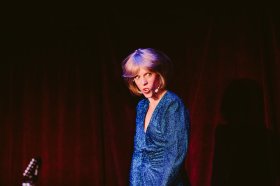Lisa Harper-Brown
As the ‘real’ Ring Cycle inexorably makes it way through three cycles of the four operas at the suitably huge State Theatre, the Recital Centre Salon is hosting the mini-operetta The Ringtone Cycle, (not to be confused with DC3’s punk rock eurodisco adaption of the Ring Cycle, presented at this year’s Comedy Festival).
This Ringtone Cycle has music by Graeme Koehne, with text by Peter Goldsworthy. In the role of Brunnhilde is soprano Lisa Harper-Brown, with the Seraphim Trio – pianist Anna Goldsworthy, violinist Helen Ayres and cellist Timothy Nankervis. The other ‘performer’ is Brunnhilde’s iPhone.
Dressed for a comfy night in at her apartment, complete with framed photo of her cat, Brunnhilde decides to those tools of the modern girl, the computer and mobile phone, as she searches for true love in cyberspace. Her experience suggests things were much easier in Wagner’s concept of the dating game, when it was Siegfried who went in search of Brunnhilde, his only defence a sword.
Our heroine soon finds that, while her computer may promise a lot, her phone (or the person at the other end of the line) fails to deliver. There are moments of intrigue, hope and happiness, to be sure, but also humiliation, rejection and despair.
But this is a comedy from the moment our heroine enters, singing into her mobile phone, reassuring her Mum that you can’t catch a computer virus from an internet date. An old joke, but it serves to acquaint the audience with what Brunnhilde is up to.
Peter Goldsworthy’s libretto is often clever, at time touching. It marries well with Graeme Koehne’s score, particularly in plaintive pieces such as “I loved you at first link” and “He rings me; he rings me not”. With a very familiar ringtone early in the piece, picked up and played with by the piano and then the whole trio, the score is dotted with references to tunes associated with ringtones or phone ads, often with extended development of the melody.
The Seraphim Trio produced some truly beautiful playing, as well as entering into the fun of the music and, occasionally, the action on stage. Anna Goldsworthy’s piano, in particular, was a constant support to the singer.
Koehne’s continuous flow of music, most of it involving the singer, recalls Wagner’s revolutionary idea of ‘speech-song’, which required Helden (heroic) voices to sing it. In this respect, Harper-Brown was a good choice for soloist, although the slower moments of reflection were the best for appreciating her strong, clear, often sweet soprano.
It’s to be hoped that future audiences will have a better understanding of the pitfalls of internet dating, as some of the best lines languished. It is one of the few occasions where I’d comment that a younger audience might be more appreciative of the wit and fun of this piece.





